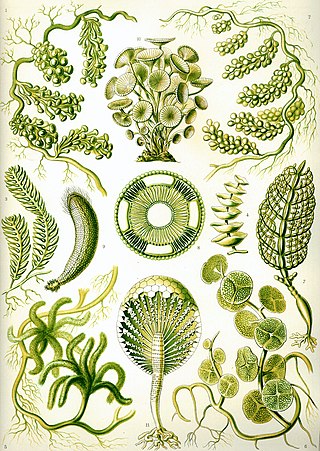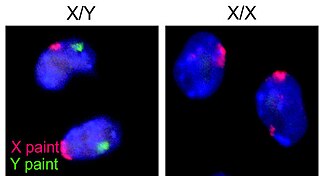Related Research Articles

The Chlorophyceae are one of the classes of green algae, distinguished mainly on the basis of ultrastructural morphology. They are usually green due to the dominance of pigments chlorophyll a and chlorophyll b. The chloroplast may be discoid, plate-like, reticulate, cup-shaped, spiral- or ribbon-shaped in different species. Most of the members have one or more storage bodies called pyrenoids located in the chloroplast. Pyrenoids contain protein besides starch. Some green algae may store food in the form of oil droplets. They usually have a cell wall made up of an inner layer of cellulose and outer layer of pectose.

Chlorophyta is a division of green algae informally called chlorophytes.

A flagellate is a cell or organism with one or more whip-like appendages called flagella. The word flagellate also describes a particular construction characteristic of many prokaryotes and eukaryotes and their means of motion. The term presently does not imply any specific relationship or classification of the organisms that possess flagella. However, several derivations of the term "flagellate" are more formally characterized.

A gamete is a haploid cell that fuses with another haploid cell during fertilization in organisms that reproduce sexually. Gametes are an organism's reproductive cells, also referred to as sex cells. The name gamete was introduced by the German cytologist Eduard Strasburger in 1878.

A gametophyte is one of the two alternating multicellular phases in the life cycles of plants and algae. It is a haploid multicellular organism that develops from a haploid spore that has one set of chromosomes. The gametophyte is the sexual phase in the life cycle of plants and algae. It develops sex organs that produce gametes, haploid sex cells that participate in fertilization to form a diploid zygote which has a double set of chromosomes. Cell division of the zygote results in a new diploid multicellular organism, the second stage in the life cycle known as the sporophyte. The sporophyte can produce haploid spores by meiosis that on germination produce a new generation of gametophytes.

A flagellum is a hair-like appendage that protrudes from certain plant and animal sperm cells, from fungal spores (zoospores), and from a wide range of microorganisms to provide motility. Many protists with flagella are known as flagellates.

Alternation of generations is the predominant type of life cycle in plants and algae. In plants both phases are multicellular: the haploid sexual phase – the gametophyte – alternates with a diploid asexual phase – the sporophyte.

Brown algae are a large group of multicellular algae comprising the class Phaeophyceae. They include many seaweeds located in colder waters of the Northern Hemisphere. Brown algae are the major seaweeds of the temperate and polar regions. Many brown algae, such as members of the order Fucales, commonly grow along rocky seashores. Most brown algae live in marine environments, where they play an important role both as food and as a potential habitat. For instance, Macrocystis, a kelp of the order Laminariales, may reach 60 m (200 ft) in length and forms prominent underwater kelp forests that contain a high level of biodiversity. Another example is Sargassum, which creates unique floating mats of seaweed in the tropical waters of the Sargasso Sea that serve as the habitats for many species. Some members of the class, such as kelps, are used by humans as food.

The Oomycetes, or Oomycota, form a distinct phylogenetic lineage of fungus-like eukaryotic microorganisms within the Stramenopiles. They are filamentous and heterotrophic, and can reproduce both sexually and asexually. Sexual reproduction of an oospore is the result of contact between hyphae of male antheridia and female oogonia; these spores can overwinter and are known as resting spores. Asexual reproduction involves the formation of chlamydospores and sporangia, producing motile zoospores. Oomycetes occupy both saprophytic and pathogenic lifestyles, and include some of the most notorious pathogens of plants, causing devastating diseases such as late blight of potato and sudden oak death. One oomycete, the mycoparasite Pythium oligandrum, is used for biocontrol, attacking plant pathogenic fungi. The oomycetes are also often referred to as water molds, although the water-preferring nature which led to that name is not true of most species, which are terrestrial pathogens.

A sporophyte is the diploid multicellular stage in the life cycle of a plant or alga which produces asexual spores. This stage alternates with a multicellular haploid gametophyte phase.

A zoospore is a motile asexual spore that uses a flagellum for locomotion in aqueous or moist environments. Also called a swarm spore, these spores are created by some protists, bacteria, and fungi to propagate themselves. Certain zoospores are infectious and transmittable, such as Batrachochytrium dendrobatidis, a fungal zoospore that causes high rates of mortality in amphibians.

A gametangium is a sex organ or cell in which gametes are produced that is found in many multicellular protists, algae, fungi, and the gametophytes of plants. In contrast to gametogenesis in animals, a gametangium is a haploid structure and formation of gametes does not involve meiosis.
Plant reproduction is the production of new offspring in plants, which can be accomplished by sexual or asexual reproduction. Sexual reproduction produces offspring by the fusion of gametes, resulting in offspring genetically different from either parent. Asexual reproduction produces new individuals without the fusion of gametes, resulting in clonal plants that are genetically identical to the parent plant and each other, unless mutations occur.
Sporogenesis is the production of spores in biology. The term is also used to refer to the process of reproduction via spores. Reproductive spores were found to be formed in eukaryotic organisms, such as plants, algae and fungi, during their normal reproductive life cycle. Dormant spores are formed, for example by certain fungi and algae, primarily in response to unfavorable growing conditions. Most eukaryotic spores are haploid and form through cell division, though some types are diploid sor dikaryons and form through cell fusion.we can also say this type of reproduction as single pollination

Ginkgo is a genus of non-flowering seed plants, assigned to the gymnosperms. The scientific name is also used as the English common name. The order to which the genus belongs, Ginkgoales, first appeared in the Permian, 270 million years ago, and Ginkgo is now the only living genus within the order. The rate of evolution within the genus has been slow, and almost all its species had become extinct by the end of the Pliocene. The sole surviving species, Ginkgo biloba, is found in the wild only in China, but is cultivated around the world. The relationships between ginkgos and other groups of plants are not fully resolved.
Myriotrichia is a genus of brown algae.

Scytothamnus australis is a brown alga species in the genus Scytothamnus found in New Zealand. It is a sulphated polysaccharide and the type species in the genus.

Allomyces is a genus of fungi in the family Blastocladiaceae. It was circumscribed by British mycologist Edwin John Butler in 1911. Species in the genus have a polycentric thallus and reproduce sexually or asexually by zoospores that have a whiplash-like flagella. They are mostly isolated from soils in tropical countries, commonly in ponds, rice fields, and slow-moving rivers.

Autospores are a type of spores that are produced by algae to enable asexual reproduction and spread. They are non-motile and non-flagellated aplanospores that are generated within a parent cell and have the same shape as the parent cell before their release. Autospores are also known as resting spores. Algae primarily use three different types of spores for asexual reproduction - autospores, zoospores, and aplanospores. Autospores occur in several groups of algae, including Eustigmatophyceae, Dinoflagellates, and green algae. One example of a colonial alga that produces autospores is Dichotomococcus. This alga generates two autospores per reproducing cell, and the autospores escape through a slit in the cell wall and remain attached to the mother cell. Some study on autospores and algae in general include looking into its use for biofuel, animal feed, food supplements, nutraceuticals, and pharmaceuticals.

Phycophthorum is a monotypic genus of protists that parasitize diatoms, containing the sole species Phycophthorum isakeiti. It was discovered in 2020 in the coastal waters of Norway, as parasites of diatoms belonging to the genus Pleurosigma.
References
- 1 2 3 4 5 6 7 Hoek, Christiaan van den; Mann, D. G.; Jahns, Hans Martin (1995). Algae: An introduction to phycology. UK: Cambridge University Press. ISBN 978-0-521-31687-3.
- 1 2 Heesch, Svenja; Peters, Akira F. (March 1999). "Scanning electron microscopy observation of host entry by two brown algae endophytic in Laminaria saccharina (Laminariales, Phaeophyceae)". Phycological Research. 47 (1): 1–5. doi:10.1111/j.1440-1835.1999.tb00277.x. ISSN 1322-0829.
- ↑ Lobban, Christopher S.; Wynne, Michael James (1981). The Biology of seaweeds. University of California Press. ISBN 0-520-04585-8.
- 1 2 Paolillo, Dominick J. (1981). "The Swimming Sperms of Land Plants". BioScience. 31 (5): 367–373. doi:10.2307/1308401. ISSN 0006-3568. JSTOR 1308401.
- 1 2 3 Norstog, Knut J.; Gifford, Ernest M.; Stevenson, Dennis Wm (2004). "Comparative Development of the Spermatozoids of Cycads and Ginkgo biloba". The Botanical Review. 70 (1): 5–15. doi:10.1663/0006-8101(2004)070[0005:CDOTSO]2.0.CO;2. ISSN 0006-8101.
- 1 2 3 4 Ogura, Y. (1967). "History of discovery of spermatozoids in Ginkgo biloba and Cycas revoluta". Phytomorphology. 17: 109–114. Retrieved 17 April 2020.
- 1 2 3 Andersen, Robert A. (2004). "Biology and systematics of heterokont and haptophyte algae". American Journal of Botany. 91 (10): 1508–1522. doi:10.3732/ajb.91.10.1508. PMID 21652306.
- 1 2 Patterson, David J. (1999). "The Diversity of Eukaryotes". The American Naturalist. 154 (S4): S96–S124. doi:10.1086/303287. ISSN 1537-5323. PMID 10527921. S2CID 4367158.
- 1 2 Lewis, Louise A.; McCourt, Richard M. (2004). "Green algae and the origin of land plants". American Journal of Botany. 91 (10): 1535–1556. doi:10.3732/ajb.91.10.1535. PMID 21652308.
- ↑ Lersten, Nels R.; Voth, Paul D. (September 1960). "Experimental Control of Zoid Discharge and Rhizoid Formation in the Green Alga Enteromorpha". Botanical Gazette. 122 (1): 33–45. doi:10.1086/336083. ISSN 0006-8071. JSTOR 2472935. S2CID 85073028.
- ↑ Bast, Felix; Shimada, Satoshi; Hiraoka, Masanori; Okuda, Kazuo (October 2009). "Asexual life history by biflagellate zoids in Monostroma latissimum (Ulotrichales)". Aquatic Botany. 91 (3): 213–218. doi:10.1016/j.aquabot.2009.06.006.
- ↑ Sato, Shinya; Beakes, Gordon; Idei, Masahiko; Nagumo, Tamotsu; Mann, David G. (26 October 2011). Lobaccaro, Jean-Marc A. (ed.). "Novel Sex Cells and Evidence for Sex Pheromones in Diatoms". PLOS ONE. 6 (10): e26923. Bibcode:2011PLoSO...626923S. doi: 10.1371/journal.pone.0026923 . ISSN 1932-6203. PMC 3202595 . PMID 22046412.
- ↑ Frey, Wolfgang; Kürschner, Harald (March 2011). "Asexual reproduction, habitat colonization and habitat maintenance in bryophytes". Flora - Morphology, Distribution, Functional Ecology of Plants. 206 (3): 173–184. doi:10.1016/j.flora.2010.04.020.
- ↑ Renzaglia, Karen S.; Bernhard, Douglas L.; Garbary, David J. (January 1999). "Developmental Ultrastructure of the Male Gamete of Selaginella". International Journal of Plant Sciences. 160 (1): 14–28. doi:10.1086/314103. ISSN 1058-5893. S2CID 85178760.
- ↑ Walker, Claire A.; van West, Pieter (February 2007). "Zoospore development in the oomycetes". Fungal Biology Reviews. 21 (1): 10–18. doi:10.1016/j.fbr.2007.02.001.
- ↑ Muccifora, S.; Gori, P. (August 2005). "Ultrastructure of mature spermatozoids in the fern Asplenium onopteris L.". Micron. 36 (6): 539–544. doi:10.1016/j.micron.2005.03.012. PMID 15975801.